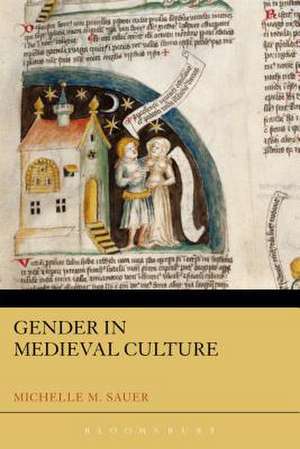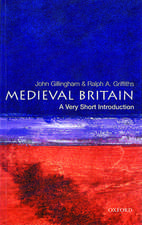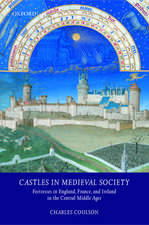Gender in Medieval Culture
Autor Dr Michelle M. Saueren Limba Engleză Paperback – 23 sep 2015
| Toate formatele și edițiile | Preț | Express |
|---|---|---|
| Paperback (1) | 190.96 lei 6-8 săpt. | |
| Bloomsbury Publishing – 23 sep 2015 | 190.96 lei 6-8 săpt. | |
| Hardback (1) | 656.23 lei 6-8 săpt. | |
| Bloomsbury Publishing – 23 sep 2015 | 656.23 lei 6-8 săpt. |
Preț: 190.96 lei
Preț vechi: 221.84 lei
-14% Nou
Puncte Express: 286
Preț estimativ în valută:
36.55€ • 38.01$ • 30.17£
36.55€ • 38.01$ • 30.17£
Carte tipărită la comandă
Livrare economică 14-28 aprilie
Preluare comenzi: 021 569.72.76
Specificații
ISBN-13: 9781441142627
ISBN-10: 1441142622
Pagini: 224
Dimensiuni: 156 x 234 x 13 mm
Greutate: 0.32 kg
Editura: Bloomsbury Publishing
Colecția Bloomsbury Academic
Locul publicării:London, United Kingdom
ISBN-10: 1441142622
Pagini: 224
Dimensiuni: 156 x 234 x 13 mm
Greutate: 0.32 kg
Editura: Bloomsbury Publishing
Colecția Bloomsbury Academic
Locul publicării:London, United Kingdom
Caracteristici
Very widely taught subject at most universities in the anglophone world
Notă biografică
Michelle M. Sauer is Professor in the Department of English at the University of North Dakota, USA.
Cuprins
Table of ContentsAcknowledgementsA Note on TextsIntroductionChapter 1: The Social World: Law, Medicine, & ScienceChapter 2: The Expected Ideal: Marriage & VirginityChapter 3: The Unexpected Actuality: 'Deviance' & TransgressionChapter 4: The Gendered Christ: Sexuality & Religion Chapter 5: The Political Sphere: Power, Labor, & EconomicsFurther ReadingGlossaryIndex
Recenzii
Gender in Medieval Culture is a serviceable and functional resource for students and instructors. It is based on a solid understanding of recent developments in medieval gender studies, provides vivid case studies, and offers a clear overview of the medieval medical and ecclesiastical discourses and ideals of gender and sexuality.
Gender in Medieval Culture is an engaging, informative, and stimulating account of men and women in the Western European Middle Ages. In this lively and ambitious study, Michelle M. Sauer explores how gender is informed by, and informs the religious, social, economic, political, legal and medical spheres. . . arguing that only by fully understanding the interaction of gender and power in the distant past, can we fully understand it today.
This is a wide-ranging and detailed introduction to the problems of applying gender theory to medieval society. It presents a comprehensive overview of the key scholarly works of the past 30 years, and explores with admirable clarity the often conflicting views of medieval commentators on the definition and display of gendered roles. Dr Sauer's study illustrates the many constraints on women's lives in both sacred and secular spheres, utilizing examples drawn from historical, literary and legal sources, but also demonstrates the ways in which men, too, were governed by a set of norms. Her comparative work will be of great use to instructors and students alike.
Professor Sauer's refreshingly clear and direct prose conveys not only information but the excitement and sheer joy of intellectual exploration. It consistently demystifies jargon, and yet all the while provides the vocabulary and critical styles its readers will need to use. The book embodies pedagogy and learning. Drawing upon Professor Sauer's experience in the classroom, her book's explanations and readings of events and texts engage readers in the act--the art--of scholarship as well as the knowledge scholarship produces.
Gender in Medieval Culture is an engaging, informative, and stimulating account of men and women in the Western European Middle Ages. In this lively and ambitious study, Michelle M. Sauer explores how gender is informed by, and informs the religious, social, economic, political, legal and medical spheres. . . arguing that only by fully understanding the interaction of gender and power in the distant past, can we fully understand it today.
This is a wide-ranging and detailed introduction to the problems of applying gender theory to medieval society. It presents a comprehensive overview of the key scholarly works of the past 30 years, and explores with admirable clarity the often conflicting views of medieval commentators on the definition and display of gendered roles. Dr Sauer's study illustrates the many constraints on women's lives in both sacred and secular spheres, utilizing examples drawn from historical, literary and legal sources, but also demonstrates the ways in which men, too, were governed by a set of norms. Her comparative work will be of great use to instructors and students alike.
Professor Sauer's refreshingly clear and direct prose conveys not only information but the excitement and sheer joy of intellectual exploration. It consistently demystifies jargon, and yet all the while provides the vocabulary and critical styles its readers will need to use. The book embodies pedagogy and learning. Drawing upon Professor Sauer's experience in the classroom, her book's explanations and readings of events and texts engage readers in the act--the art--of scholarship as well as the knowledge scholarship produces.

















